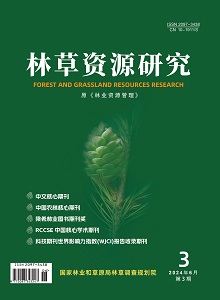Research on Forest Ecosystem Carbon Sinks in Jiangsu Province
LIN Hong, MA Xu, HE ZaiHua, LIU Bin, HUANG Zhong, TIAN XingJun
2014,(1):
89-97.
doi:10.13466/j.cnki.lyzygl.2014.01.018
 Asbtract
(
403 )
Asbtract
(
403 )
 PDF (1079KB)
(
564
)
References |
Related Articles |
Metrics
PDF (1079KB)
(
564
)
References |
Related Articles |
Metrics
On the basis of the field investigation of sample plots in Jiangsu province in 2011-2012 and the results of forest resource survey in 2010,we calculated the forest ecosystem carbon storage and density of Jiangsu province.Until 2012,total carbon storage of forest ecosystem was 179.16 Tg C,and the carbon storages in arbor layer,shrub-grass layer,litter layer,and soil were 57.95Tg C,6.90Tg C,14.44Tg C,99.87Tg C,accounting for 32.44%,3.85%,8.05%,and 55.66% of the total,respectively.The average carbon density in the forest ecosystems was 143.00T/hm2,with 83.65 T/hm2 in soil,51.43T/hm2 in arbor layer,5.24T/hm2 in litter layer,and 2.66T/hm2 in shrub-grass layer.Different types of the forest ecosystems had different carbon storage and density,and values of carbon storage in deciduous broadleaved forest was highest(102.03Tg C),bamboo forest had the lowest values(3.90Tg C).Values of density in evergreen broadleaved forest was highest(170.97 T/hm2),deciduous broad-leaved forest had the lowst values(109.99 T/hm2).According to age group,forest carbon storage was mainly distributed in the age groups of below 10 years,10 to 20 years,values were respectively 11.36 Tg C,27.92 Tg C,which accounted for 25.07% and 61.63% of the total carbon.Correlation analysis between aboveground biomass and soil characteristics showed that aboveground biomass and characteristics of soil carbon content,nitrogen content are positively correlated,and aboveground biomass appeared strongly related to soil nitrogen content (p=0.03),correlation of aboveground biomass and soil water content was not significant.

